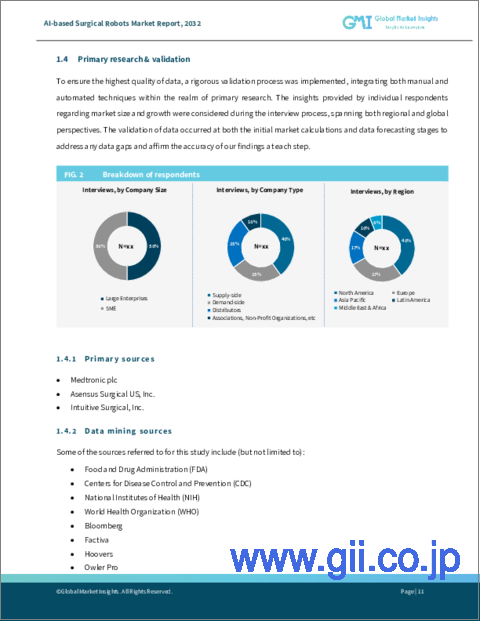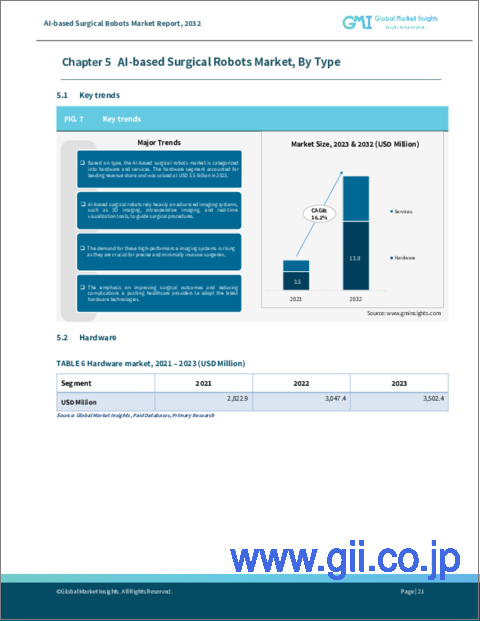|
|
市場調査レポート
商品コード
1572465
AIベースの手術ロボット市場、市場動向、成長促進要因、産業動向分析と予測、2024年~2032年AI-based Surgical Robots Market, Opportunity, Growth Drivers, Industry Trend Analysis and Forecast, 2024-2032 |
||||||
カスタマイズ可能
|
|||||||
| AIベースの手術ロボット市場、市場動向、成長促進要因、産業動向分析と予測、2024年~2032年 |
|
出版日: 2024年08月19日
発行: Global Market Insights Inc.
ページ情報: 英文 110 Pages
納期: 2~3営業日
|
全表示
- 概要
- 目次
AIベースの手術ロボットの世界市場規模は、2023年に57億米ドルとなった。
予測では、2024年から2032年までのCAGRは16.2%と予測され、堅調な成長軌道を示しています。この急成長は、技術的進歩、外科手術の増加、政府の支援策や資金援助などによるところが大きいです。
低侵襲手術は、外傷が少なく回復が早いことで知られており、AIベースの手術ロボットの採用が増加しています。これらのロボットは、そのような手術に不可欠な、より高度な制御と精度を提供します。例えば、メリタス・ヘルス社によると、米国では年間1,500万件以上の腹腔鏡手術が行われています。さらに、AIベースの手術ロボットは精度を高め、ヒューマンエラーのリスクを軽減します。その結果、患者の転帰が向上し、合併症の発生率が減少し、入院期間が短縮されます。
ロボット手術にAIを導入することで、効率性、安全性、有効性が向上し、外科手術に革命をもたらしています。AIの統合は、繊細な操作を容易にし、組織の損傷を最小限に抑え、回復時間を短縮し、患者の転帰を向上させる。操作を合理化することで、AIは手術時間を短縮するだけでなく、同じ時間枠でより多くの手技を可能にします。この効率性は、需要の高い手術環境では不可欠であり、オペレーションのスループットを向上させ、ヘルスケアコストを抑制します。さらに、AIを活用した予測分析とシミュレーションツールは、術前計画を強化します。外科医が多様なシナリオと結果を視覚化できるようにすることで、これらのツールは複雑な手術に備え、術中の驚きを減らし、手術結果を向上させる。
AIベースの手術ロボット産業は、タイプ、用途、最終用途、地域によって分類されます。
2023年には、ハードウェア分野が35億米ドルの収益シェアを占めました。3Dイメージング、術中イメージング、リアルタイム可視化ツールなどの高度なイメージングシステムは、AIベースの外科手術を導くために極めて重要です。このような高性能画像システムの需要が急増するにつれ、ヘルスケアプロバイダーは最先端のハードウェア技術を採用するようになっています。これには、高度なロボットアーム、精密機器、AI統合画像処理システムなどが含まれ、これらすべてが医療の質の向上を目指しています。
2023年には、病院が73.9%と圧倒的な市場シェアを占めています。神経外科、心臓血管外科、腫瘍学など、病院における専門的な外科サービスは、AIベースの手術ロボットに計り知れない価値を見出します。これらのロボットは、正確さとリアルタイムの意思決定が求められる複雑な手術の実行に役立っています。さらに、病院が拡張性と適応性に優れた手術ソリューションを求める中、AIベースの手術ロボットのモジュール式でカスタマイズ可能な性質は、特に手術能力の拡大を目指す病院にとって大きな魅力となっています。
北米のAIベースの手術ロボット市場は、2023年に38億米ドルの売上を記録しました。予測では、2024年から2032年までのCAGRは14.9%です。同地域では、高齢化、選択的手術の増加、手術手技の進化に後押しされ、外科手術の一貫した増加しています。この急増する需要に対応するため、AIベースの手術ロボットは、特に大量手術センターで顕著な地位を確立しつつあります。さらに、北米の規制状況はAI手術技術の採用に有利です。米国の規制機関、特にFDAは、AIを搭載した手術ロボットを含む医療機器に合理化された承認経路を提供し、市場参入を促進しています。
目次
第1章 調査手法と調査範囲
第2章 エグゼクティブサマリー
第3章 業界洞察
- エコシステム分析
- 業界への影響要因
- 促進要因
- 手術ロボットの採用増加
- 手術件数の増加
- 自動ロボット手術における人工知能の統合の増加
- 技術の進歩
- 慢性疾患の増加
- 業界の潜在的リスク&課題
- 手術用ロボットの高コスト
- 規制上の課題と安全性への懸念
- 促進要因
- 成長可能性分析
- 技術展望
- 今後の市場動向
- 規制状況
- 償還シナリオ
- ポーター分析
- PESTEL分析
- ギャップ分析
- バリューチェーン分析
- 政策展望
第4章 競合情勢
- イントロダクション
- 企業マトリックス分析
- 企業シェア分析
- 競合のポジショニング・マトリックス
- 戦略ダッシュボード
第5章 市場推計・予測:タイプ別、2021年~2032年
- 主要動向
- ハードウェア
- ロボットシステム
- 機器および付属品
- サービス
第6章 市場推計・予測:用途別、2021年~2032年
- 主要動向
- 一般外科
- 婦人科手術
- 泌尿器外科
- 整形外科
- 脳神経外科
- その他の用途
第7章 市場推計・予測:最終用途別、2021年~2032年
- 主要動向
- 病院
- 外来手術センター(ASCs)
第8章 市場推計・予測:地域別、2021年~2032年
- 主要動向
- 北米
- 米国
- カナダ
- 欧州
- ドイツ
- 英国
- フランス
- スペイン
- イタリア
- オランダ
- その他欧州
- アジア太平洋
- 中国
- 日本
- インド
- オーストラリア
- 韓国
- その他アジア太平洋
- ラテンアメリカ
- ブラジル
- メキシコ
- アルゼンチン
- その他ラテンアメリカ
- 中東・アフリカ
- 南アフリカ
- サウジアラビア
- アラブ首長国連邦
- その他中東とアフリカ
第9章 企業プロファイル
- Accuray Incorporated
- Asensus Surgical US, Inc.
- CMR Surgical, Inc.
- Intuitive Surgical, Inc.
- Medtronic plc
- meerecompany Inc.
- Moon Surgical
- Smith and Nephew
- Stryker Corporation
- Zimmer Biomet
The Global AI-based Surgical Robots Market was valued at USD 5.7 billion in 2023. Projections indicate a robust growth trajectory, with an anticipated CAGR of 16.2% from 2024 to 2032. This surge can be largely attributed to technological advancements, an uptick in surgical procedures, and supportive government initiatives and funding, among other factors.
Minimally invasive procedures, known for being less traumatic and promoting quicker recovery, are increasingly adopting AI-based surgical robots. These robots provide enhanced control and precision, crucial for such surgeries. For instance, Meritas Health reports that the U.S. sees over 15 million laparoscopic surgeries annually. Moreover, AI-based surgical robots enhance precision, mitigating human error risks. This leads to superior patient outcomes, reduced complication rates, and shorter hospital stays.
The infusion of AI into robotic surgeries is revolutionizing surgical practices, enhancing their efficiency, safety, and effectiveness. AI integration facilitates delicate maneuvers, minimizing tissue damage, shortening recovery times, and boosting patient outcomes. By streamlining operations, AI not only cuts down surgery durations but also allows for a greater number of procedures in the same timeframe. This efficiency is vital in high-demand surgical environments, enhancing operational throughput and curbing healthcare costs. Furthermore, AI-driven predictive analytics and simulation tools bolster preoperative planning. By enabling surgeons to visualize diverse scenarios and outcomes, these tools prepare them for intricate surgeries, reducing intraoperative surprises and elevating surgical results.
The AI-based surgical robots industry is classified based on type, application, end-use, and region.
In 2023, the hardware segment led the revenue share, valued at USD 3.5 billion. Advanced imaging systems, including 3D imaging, intraoperative imaging, and real-time visualization tools, are pivotal for guiding AI-based surgical procedures. As the demand for these high-performance imaging systems surges, healthcare providers are increasingly adopting cutting-edge hardware technologies. This encompasses advanced robotic arms, precision instruments, and AI-integrated imaging systems, all aimed at elevating care quality.
In 2023, hospitals commanded a dominant market share of 73.9%. Specialized surgical services in hospitals, such as neurosurgery, cardiovascular surgery, and oncology, find immense value in AI-based surgical robots. These robots are instrumental in executing intricate surgeries that demand precision and real-time decision-making. Furthermore, as hospitals seek scalable and adaptable surgical solutions, the modular and customizable nature of AI-based surgical robots becomes a significant draw, especially for those aiming to broaden their surgical capabilities.
North America AI-based surgical robots market held a revenue of USD 3.8 billion in 2023. Projections suggest a CAGR of 14.9% from 2024 to 2032. The region witnesses a consistent rise in surgical procedures, fueled by an aging demographic, increased elective surgeries, and evolving surgical techniques. To cater to this surging demand, AI-based surgical robots are finding a prominent place, especially in high-volume surgical centers. Additionally, the regulatory landscape in North America favors the adoption of AI surgical technologies. U.S. regulatory bodies, notably the FDA, offer streamlined approval pathways for medical devices, including AI-powered surgical robots, expediting their market entry.
Table of Contents
Chapter 1 Methodology and Scope
- 1.1 Market scope and definitions
- 1.2 Research design
- 1.2.1 Research approach
- 1.2.2 Data collection methods
- 1.3 Base estimates and calculations
- 1.3.1 Base year calculation
- 1.3.2 Key trends for market estimation
- 1.4 Forecast model
- 1.5 Primary research and validation
- 1.5.1 Primary sources
- 1.5.2 Data mining sources
Chapter 2 Executive Summary
- 2.1 Industry 360° synopsis
Chapter 3 Industry Insights
- 3.1 Industry ecosystem analysis
- 3.2 Industry impact forces
- 3.2.1 Growth drivers
- 3.2.1.1 Increasing adoption of surgical robots
- 3.2.1.2 Rising number of surgical procedures
- 3.2.1.3 Growing integration of artificial intelligence in automated robotic surgeries
- 3.2.1.4 Technological advancements
- 3.2.1.5 Increasing prevalence of chronic diseases
- 3.2.2 Industry pitfalls and challenges
- 3.2.2.1 High cost of surgical robots
- 3.2.2.2 Regulatory challenges and safety concerns
- 3.2.1 Growth drivers
- 3.3 Growth potential analysis
- 3.4 Technology landscape
- 3.5 Future market trends
- 3.6 Regulatory landscape
- 3.7 Reimbursement scenario
- 3.8 Porter's analysis
- 3.9 PESTEL analysis
- 3.10 Gap analysis
- 3.11 Value-chain analysis
- 3.12 Policy outlook
Chapter 4 Competitive Landscape, 2023
- 4.1 Introduction
- 4.2 Company matrix analysis
- 4.3 Company market share analysis
- 4.4 Competitive positioning matrix
- 4.5 Strategy dashboard
Chapter 5 Market Estimates and Forecast, By Type, 2021 - 2032 ($ Mn)
- 5.1 Key trends
- 5.2 Hardware
- 5.2.1 Robotic systems
- 5.2.2 Instruments and accessories
- 5.3 Services
Chapter 6 Market Estimates and Forecast, By Application, 2021 - 2032 ($ Mn)
- 6.1 Key trends
- 6.2 General surgery
- 6.3 Gynecology surgery
- 6.4 Urologic surgery
- 6.5 Orthopedic surgery
- 6.6 Neurosurgery
- 6.7 Other applications
Chapter 7 Market Estimates and Forecast, By End-use, 2021 - 2032 ($ Mn)
- 7.1 Key trends
- 7.2 Hospitals
- 7.3 Ambulatory surgical centers (ASCs)
Chapter 8 Market Estimates and Forecast, By Region, 2021 - 2032 ($ Mn)
- 8.1 Key trends
- 8.2 North America
- 8.2.1 U.S.
- 8.2.2 Canada
- 8.3 Europe
- 8.3.1 Germany
- 8.3.2 UK
- 8.3.3 France
- 8.3.4 Spain
- 8.3.5 Italy
- 8.3.6 Netherlands
- 8.3.7 Rest of Europe
- 8.4 Asia Pacific
- 8.4.1 China
- 8.4.2 Japan
- 8.4.3 India
- 8.4.4 Australia
- 8.4.5 South Korea
- 8.4.6 Rest of Asia Pacific
- 8.5 Latin America
- 8.5.1 Brazil
- 8.5.2 Mexico
- 8.5.3 Argentina
- 8.5.4 Rest of Latin America
- 8.6 Middle East and Africa
- 8.6.1 South Africa
- 8.6.2 Saudi Arabia
- 8.6.3 UAE
- 8.6.4 Rest of Middle East and Africa
Chapter 9 Company Profiles
- 9.1 Accuray Incorporated
- 9.2 Asensus Surgical US, Inc.
- 9.3 CMR Surgical, Inc.
- 9.4 Intuitive Surgical, Inc.
- 9.5 Medtronic plc
- 9.6 meerecompany Inc.
- 9.7 Moon Surgical
- 9.8 Smith and Nephew
- 9.9 Stryker Corporation
- 9.10 Zimmer Biomet






